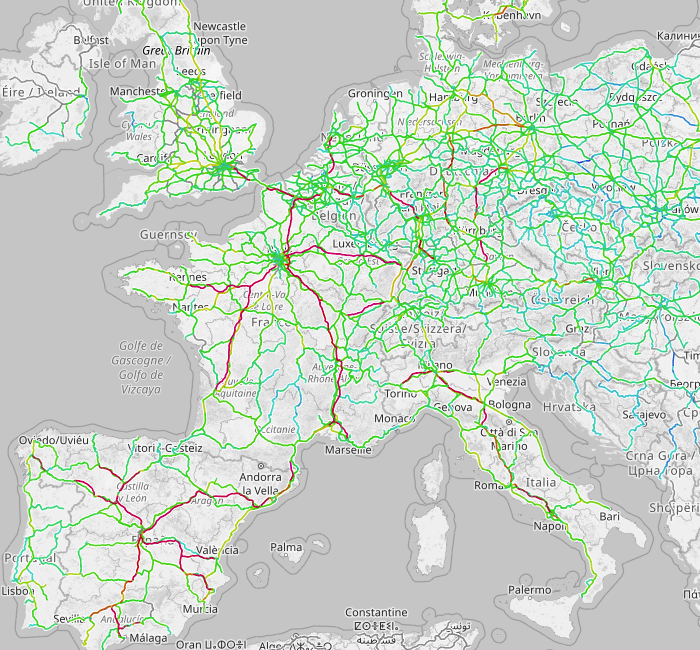Germany’s slow trains
Germany has good regional rail. Not as great as Japan or Switzerland, but better than many in Europe.
But long-distance travel is a pain in the ass. Germans like their Autobahn fast, but their ICE slow.
(ICE = Inter-City Express, the supposedly fast trains.)
When I’m in Germany, my most frequent connection is Köln/Bonn to Berlin.
So I was happy to hear that Deutsche Bahn will introduce a non-stop train between Köln (Cologne) and Berlin.
This ‘sprinter’ promises to reduce travel time to under 4 hours.
So far, the fastest trip takes 4h 20mins and the average 4h 40m.
Good news. Small progress.
However, let’s consider an international comparison.
Alta Velocidad
Madrid to Barcelona is about the same distance as Berlin to Köln.
Yet, instead of 4 hours, the non-stop train needs 2½ hours between Madrid and Barcelona.
The table below gives a summary. Data: Rome2Rio
| Air km | Rail km | Time | km/h | |
|---|---|---|---|---|
| Madrid-Barcelona | 505 | 606 | 2h 50m | 214 |
| M-B non-stop | 2h 30m | 242 | ||
| Berlin-Köln | 478 | 548 | 4h 40m | 117 |
| B-K non-stop | 3h 55m | 140 | ||
| Difference | 27 | 58 | -1h 50m | 96 |
| Diff. non-stop | -1h 25m | 102 |

Weep at the speed difference!
The normal Madrid-Barcelona train travels at 214 km/h, the non-stop at 242 km/h.
The German pair is about 100 km/h slower.
Even the proposed Berlin-Köln sprinter achieves only 140 km/h. Hardly high-speed.
The normal ICE, making several stops along the way, resembles a fast regional train at 117 km/h.
Bad track
Fewer stops save some time. But the root cause of Germany’s sluggishness remains: the tracks are not built for high-speed.
While modern ICE train-sets can go 300 km/h, many tracks allow just 200 km/h.
The heavy-traffic section between Köln and Hannover is a particular bottleneck.
Consider this Openrailwaymap, showing top speeds:

True high-speed lines are in red (over 250 km/h).
Germany has a dense network, optimised for regional traffic, but few rapid routes.
France and Spain struggle with their regional net. In long-distance high-speed, they are ahead.
Air competition
Travel times matter.
Flights between Berlin and Köln/Bonn take about 1 hour. Add 1 hour before departure, 2 hours beats any other option.
(Frequent flyers know they can arrive 30 mins before boarding, reducing the journey to under 2 hours.)
Germany’s domestic flight market is strong, with many options and cheap tickets.
Before corona, per year over 1.6 million flew from Köln/Bonn to Berlin.
ICE trains are often late. I can’t remember ever arriving on time for Berlin-Köln. So much for German punctuality.
On average, prices are similar.
Regular rail customers with a BahnCard (a loyalty scheme) might even have the edge.
However, if you are flexible time-wise, it’s easy to get air bargains below train tickets.
The magic 3-hour mark
People measure distances not in kilometres, but in time.
And travellers have limits, such as the 3-hour rule, as research has found out. (Average journey time is around 1 hour.)
For routine acts — family visits, normal business trips, short holidays — people are prepared to travel up to 3 hours.
After 3 hours, a sharp decline sets in. Anything longer is a niche market.
This rule applies to flying, car driving, and rail hikes.
Psychology plays a part. 2h 30m is better than 2h 50m, but passengers will be flexible. Whereas 2h 50m to 3h 10m will see a fall in trips.
Tourist operators and airlines know this and fight to keep schedules under 3 hours.
Rail needs to learn this lesson.
Let’s hope
One day, hopefully, Germany will build more high-speed tracks.
The key would be a new dedicated Köln-Hannover line. The extension to Berlin is already reasonably fast.
If Berlin-Köln had the same 242 km/h speed as Madrid-Barcelona, then non-stop would take 2h 16m; almost as fast as flying.
If, in addition, airlines finally had to pay tax on their fuel, rail would gain a clear price advantage.
One day, hopefully.
¶